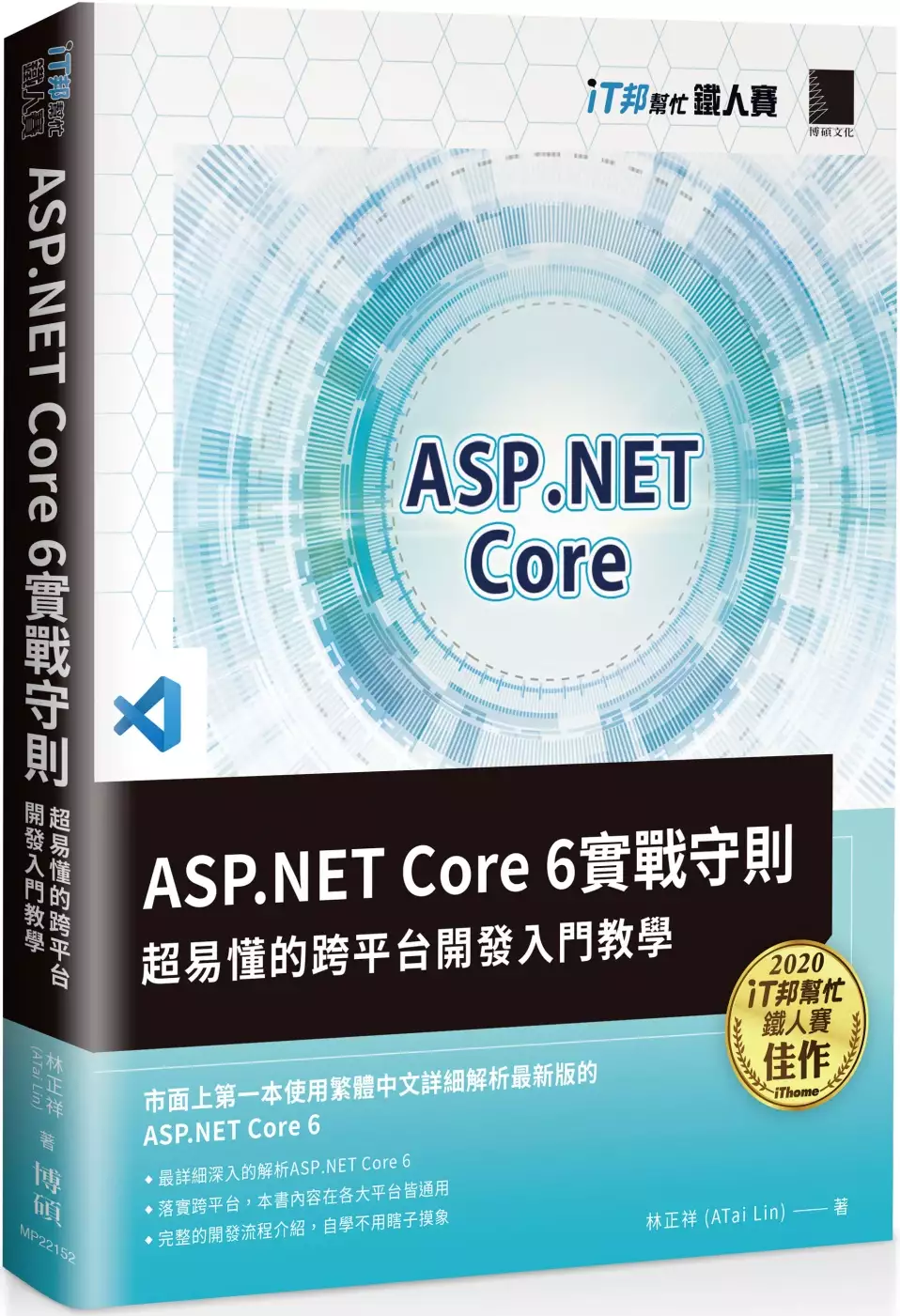Middleware C#的問題,透過圖書和論文來找解法和答案更準確安心。 我們找到下列懶人包和總整理
Middleware C#的問題,我們搜遍了碩博士論文和台灣出版的書籍,推薦林正祥寫的 ASP.NET Core 6實戰守則:超易懂的跨平台開發入門教學(iT邦幫忙鐵人賽系列書) 和的 Handbook of Real-Time Computing都 可以從中找到所需的評價。
這兩本書分別來自博碩 和所出版 。
世新大學 資訊管理學研究所(含碩專班) 吳翠鳳所指導 周建竹的 公有雲端企業資料庫即時同步備援到企業自有機房之研究 (2022),提出Middleware C#關鍵因素是什麼,來自於備援備份、雲端計算、同步、關聯式資料庫。
而第二篇論文國立臺北教育大學 資訊科學系碩士班 蕭瑛東所指導 李宜杰的 醫療物聯網產業技術發展與未來展望之研究 (2021),提出因為有 醫療物聯網、人工智慧、大數據、安全機制、新冠肺炎病毒的重點而找出了 Middleware C#的解答。
ASP.NET Core 6實戰守則:超易懂的跨平台開發入門教學(iT邦幫忙鐵人賽系列書)

為了解決Middleware C# 的問題,作者林正祥 這樣論述:
市面上第一本使用繁體中文詳細解析最新版的ASP.NET Core 6 本書內容改編自第12屆iT邦幫忙鐵人賽,Modern Web組佳作網站系列文章-《我與ASP.NET Core的30天》,並使用了最新C# 10的語言特性,來作為範例。 書中的內容主要是讓剛開始想接觸ASP.NET Core的開發人員正確的建立基本觀念,對於進階的開發人員也可以作為工具書參考。 目標讀者 1.有程式開發經驗,想入門ASP.NET Core 6的開發人員 2.有ASP.NET Core開發經驗,缺少一本完善的工具書的開發人員 本書特色
◎用最簡潔的說明方式,讓艱深的觀念也能變簡單 ◎從零開始,完整介紹ASP.NET Core 6的核心功能 ◎使用dotnet CLI作為範例主軸,內容在任何平台上都適用,能夠確實了解到跨平台開發的魅力 專業推薦 都說要站在巨人的肩上,一本好的參考書,能讓你減少你摸索的時間,快速領略ASP.NET Core的武功心法,站在此書之上,大膽的跳上去.NET Core這班無限列車,觀賞.NET Core既豐富又美麗的開發世界。Coding (.NET) for fun!——微軟MVP最有價值專家,陳傳興/Bruce Chen,blog.kkbru
ce.net
公有雲端企業資料庫即時同步備援到企業自有機房之研究
為了解決Middleware C# 的問題,作者周建竹 這樣論述:
由於在近十年來網路通訊技術的快速發展,雲端服務在手機時代已經被各企業和個人所採用,在此平台上,提供的服務,可以使租用戶能快速建構符合他們本身所需要的資料系統,另外在以前雲端服務及網路通訊技術尚未普及的年代,資訊系統備援是有地區距離的限制,而現在,在地端和雲端聯結更緊密的時代,在雲端各應用系統的後端的關聯式資料庫儲存重要的交易資料,其中備援設計更是極為重要。在本論文中研究的目的將以雲端的關聯式資料庫層級即時備援到地端,從可用性、即時性、保密安全性、持久性保存和搬遷性等做探討,本研究所採用的方式為在雲端租用和設定環境和地端架設環境,建構本研究之研究模型,進行雲端到地端在關聯式資料庫層級的備援探討
分析,並使用雲端運算業者Azure的計量統計圖表做資料蒐集及資料分析,呈現雲端硬碟讀寫累積使用量和網路頻寬累積使用量的數據並進行分析和探討,企業將可依照自己業務特性,做出符合最佳化的雲端資料庫備援到地端資料庫方式的決策。
Handbook of Real-Time Computing

為了解決Middleware C# 的問題,作者 這樣論述:
The aim of this handbook is to summarize the recent rapidly developed real-time computing technologies, from theories to applications. This handbook benefits the readers as a full and quick technical reference with a high-level historic review of technology, detailed technical descriptions and the l
atest practical applications. In general, the handbook is divided into three main parts (subjected to be modified): theory, design, and application covering different but not limited to the following topics: - Real-time operating systems- Real-time scheduling- Timing analysis- Programming languages
and run-time systems- Middleware systems - Design and analysis tools - Real-time aspects of wireless sensor networks - Energy aware real-time methods Professor Yu-Chu Tian is a Professor of Computer Science and the Head of the NetCom Discipline within the School of Electrical Engineering and Compu
ter Science (EECS) at Queensland University of Technology (QUT). He is an Australia Research Council CoE recognized Expert of International Standing, and an Assessor for research grant applications and research quality evaluation for ARC and several other funding agencies and organizations. He is a
member of IEEE, IEAust, and IChemE. As an Associate Editor, he is serving the journal of Information Sciences published by Elsevier and Asia-Pacific Journal of Chemical Engineering published by Wiley. He is an ACM Reviewer for Computing Reviews. He is also acting as a Reviewer for a number of intern
ational journals. He is a technology provider to several Australian companies for complex systems engineering, real-time/embedded systems, and intelligent systems and robotics. Dr Tian is currently supervising 9 PhD/Masters students and several postdoc/visiting research fellows. Professor Tian rece
ived the B.E. degree in Electrical Engineering (industrial automation) from Wuhan Institute of Technology, China, in 1982, the M.E. degree in Electrical Engineering (industrial automation/systems engineering) from East China University of Science and Technology, China, in 1987, the Ph.D. degree in E
lectrical Engineering (Industrial Automation/Intelligent Control and Decision) from Zhejiang University, China, in 1993, and the Ph.D. degree in Computer and Software Engineering from The University of Sydney, Australia, in 2009. Professor Tian joined the Naval Academy of Engineering, China, in 198
7, as a Lecturer in systems engineering. From 1994 to 1998, he worked at the Department of Electrical Engineering and the Institute of Industrial Process Control, Zhejiang University, China, where he was promoted to Associate Professor in Electrical Engineering in 1995. From 1996 to 1998, he was on
leave from Zhejiang University to Hong Kong University of Science and Technology, as a Research Associate working on complex systems and process control. He moved to Australia in 1998, working as a Research Fellow at Curtin University of Technology. In 1999, he was elected as one of the four Western
Australia Strategic Research Fellows. Since 2002, he has been working at Queensland University of Technology, Brisbane, Australia, initially as a Lecturer, later as a Senior Lecturer, the Networking Teaching Group Leader and Associate Professor in Computer Science, and currently as a Professor of C
omputer Science and the Head of the Discipline of Networks and Communications (NetCom). He also worked as a visiting professor in 2007 at the Department of Computer Science, The University of Maryland at College Park, USA. Professor Tian received the prestigious Outstanding Young Researcher Award f
rom Zhejiang Province in 1995 while working at Zhejiang University. He also won the Western Australia State Government Strategic Research Fellowship in 1999. As the Chief Investigator, Professor Tian has won/completed over 20 research grants and projects, including 5 funded by Australian Research Co
uncil (ARC), 2 funded by Australian Cooperative Research Centre (CRC) and 1 funded by Australian Government Department of Education, Science and Training (DEST). He holds a patent on real-time control of large-scale and continuous galvanizing line. He has published a monograph on computation of math
ematical models for complex industrial processes. He has also credited over 160 refereed papers in his publication record.David C Levy is an Honorary Associate Professor in the School of Electrical and Information Engineering at the University of Sydney. He was Head of the disciplines of Computer an
d Software Engineering and Head of School prior to his leaving to pursue a private consulting career. He now acts as a technical advisor to two start-ups, does some occasional teaching in Australia and China and continues to supervise several graduate research projects. He has supervised over 50 gra
duate students to completion, received grants totaling in excess of 2.5 million and been on the organizing committee of 17 conferences, chairing 6, He is a member of the IEEE, ACM and served on the CDIO Council and on the Real Time Architectures committee of IFAC. He has acted as an assessor for gra
nt applications in South Africa and Australia and has served as a reviewer for many conference papers.Dr Levy received the B.E. degree in Electrical Engineering from the University of Natal, Durban, South Africa in 1970, followed by the MSc and PhD from the same institution. He taught Electronic Eng
ineering at the University of Natal, with stints at the Technion, Israel and Clemson, USA. After an extended visit to the CSIRO in Australia, Dr Levy took up a position at the University of Sydney in 1994 where he led major curriculum revisions and served as Head of School.Dr Levy holds two patents
on embedded systems for chemical sensors. He has over 200 refereed papers on his publication record, along with a book and two book chapters.
醫療物聯網產業技術發展與未來展望之研究
為了解決Middleware C# 的問題,作者李宜杰 這樣論述:
本文藉由研究文獻、產業資料及技術報告的內容,進行分析醫療物聯網的產業及技術現況,並進一步探討在全球新冠肺炎病毒疫情肆虐下,醫療物聯網扮演降低疫情衝擊之功能及角色。使用醫療物聯網作為健康監視系統,可以通過使用可穿戴健康監視設備、無線人體局域網、人工智慧和基於雲端遠程健康測試來提供即時監視。所已利用醫療物聯網功能組件(例如數據收集,存儲,傳輸和分析)來控制傳染病傳播的預警系統會很有幫助。本研究除了說明醫療物聯網的結構、生態系統、應用程式及穿戴裝置外,也介紹認知醫療物聯網及人本角度的醫療物聯網,並特別於第三章研究方法於實施,說明了「降低疫情衝擊的醫療物聯網結構」、「醫療物聯網中的人工智慧和大數據技
術」、「醫療物聯網的安全機制」、「各國(台灣、韓國、德國)因應新冠肺炎病毒上的醫療物聯網應用和技術」、「應用醫療物聯網降低新冠肺炎病毒疫情衝擊」。最後本研究說明了醫療物聯網未來的挑戰為「安全機制」、「安全有效的演算法」、「能源效率」、「交互操作、標準化及規格」、「隱私」及「信任」等潛在問題,以及對產業及後續研究提出建議。